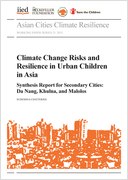Climate change risks and resilience in urban children in Asia
 Climate change is a key challenge for Asian cities in the global south. Already half of Asia-Pacific’s urban population live in secondary cities of less than 1 million, and as urbanisation continues more people will be exposed to direct and indirect hazards of climate change. The impacts will continue to devastate lives and homes – and have the potential to undo many development gains of the last few decades. Understanding these impacts begins to equip communities, governments and stakeholders to prevent long-term development losses. This paper suggests that those most susceptible to climate change impacts are the children who live in slums, informal settlements and on the streets of secondary cities, as their exposure to increasing and dramatic weather events, disease outbreaks and fluctuations in temperature are made worse by entrenched poverty, economic recession, youth unemployment and fragile institutions. This multi-city study undertaken by IIED in partnership with Save the Children argues for a profound change in current thinking. The study looks at three secondary Asian cities: Khulna (Bangladesh), Malolos (Philippines) and Da Nang (Vietnam). It considers the opportunities and gaps between current urban and climate change planning and argues for greater focus on secondary cities – in particular those cities at highest risk in Asia. It concludes by putting forward recommendations for government and non-government actors alike.
Climate change is a key challenge for Asian cities in the global south. Already half of Asia-Pacific’s urban population live in secondary cities of less than 1 million, and as urbanisation continues more people will be exposed to direct and indirect hazards of climate change. The impacts will continue to devastate lives and homes – and have the potential to undo many development gains of the last few decades. Understanding these impacts begins to equip communities, governments and stakeholders to prevent long-term development losses. This paper suggests that those most susceptible to climate change impacts are the children who live in slums, informal settlements and on the streets of secondary cities, as their exposure to increasing and dramatic weather events, disease outbreaks and fluctuations in temperature are made worse by entrenched poverty, economic recession, youth unemployment and fragile institutions. This multi-city study undertaken by IIED in partnership with Save the Children argues for a profound change in current thinking. The study looks at three secondary Asian cities: Khulna (Bangladesh), Malolos (Philippines) and Da Nang (Vietnam). It considers the opportunities and gaps between current urban and climate change planning and argues for greater focus on secondary cities – in particular those cities at highest risk in Asia. It concludes by putting forward recommendations for government and non-government actors alike.
